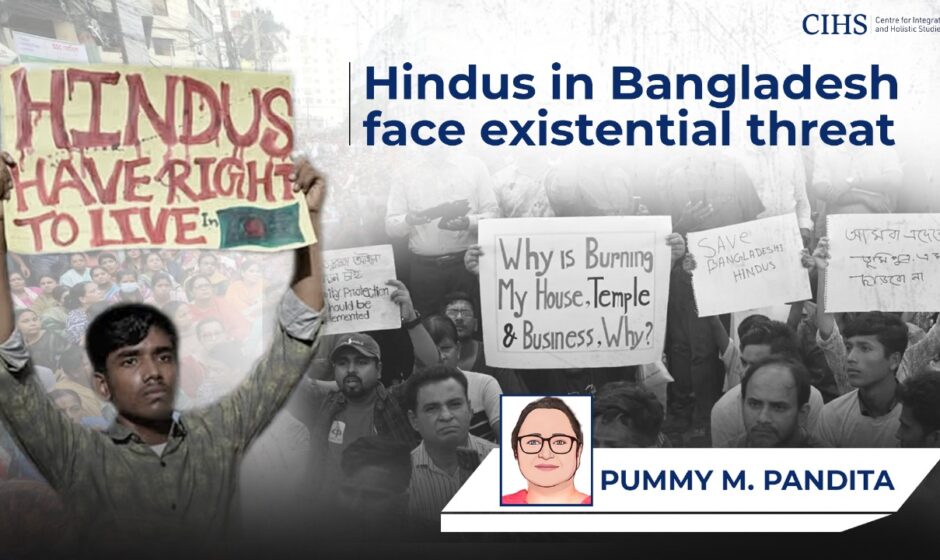CIHS, UN reports meticulously documented atrocities against minorities while Yunus government is on denial mode.
Pummy M Pandita
Centre for Integrated and Holistic Studies (CIHS) had in August 2024 released a report titled “Hindu Genocide Unfolding in Bangladesh,” detailing systematic persecution of Hindus in that country. The report highlighted how minorities and in particular Hindus suffered oppression, forced conversions and violent attacks since partition of India in 1947. With the Hindu population dwindling from nearly 30 per cent in 1947 to less than 8 per cent today, the report documented the ” … ongoing ethnic cleansing.”

CIHS report findings are further corroborated by United Nations Human Rights (UNHR) Office which released its own scathing report on the persecution of Hindus in Bangladesh.
UN report reinforces the notion of targeted violence, displacement and systemic discrimination against Hindus, echoing concerns previously voiced by CIHS. The two reports underscore severity of crisis and the urgent need for international action.
US Director of National Intelligence Tulsi Gabbard, in an interview, stated, “The long-time unfortunate persecution, killing, and abuse of religious minorities—Hindus, Buddhists, Christians, Catholics, and others—have been a major area of concern for the United States government and, of course, President Trump and his administration”.
Bangladeshi however was unmoved and went on a denial mode. As per media reports, Chief Adviser’s press wing of Bangladesh’s interim government stated, “Bangladesh as a nation traditionally practices Islam that is famously inclusive and peaceful and it has made remarkable strides in its fight against extremism and terrorism.”
Such response starkly contrasts the reality documented in both CIHS and UNHR reports. UNHR observations highlight a harsh reality: a systematic record of violence, displacement and persecution against a religious minority group in a state that takes pride in pluralism. This report is presented against the backdrop when rising extremism in South Asia is drawing international attention to the region and makes it acutely necessary that the situation must be evaluated factually with recourse to historical reality.
Some specific incidents highlighted in the report are torching of three temples and the looting of about 20 houses in Burashardubi, Hatibandha and Lalmonirhat.
UN report identifies these attacks to factors like religious and ethnic discrimination, targeted attacks on supposed supporters of former Awami League government among minorities, local communal land disputes, and personal conflicts. It also mentions involvement of some members and supporters of Jamaat-e-Islami and Bangladesh Nationalist Party (BNP) in perpetuating violence.
Even after initial denials, Bangladesh’s interim caretaker government admitted at least 88 incidents of violence against minorities, predominantly Hindus, after August 2024.
These happenings have raised significant concerns both within the country and globally, emphasizing urgent need for effective measures to protect minority communities in Bangladesh.
Bangladesh has witnessed a considerable increase in widespread violence erupted following the ousting of former Prime Minister Sheikh Hasina in August 2024, disproportionately affecting Hindu minorities.
UN report documents that Hindu homes, businesses and temples were targeted on a systematic basis particularly in rural and historically tense areas. Some of the notable incidents include:
- Thakurgaon, Lalmonirhat and Dinajpur: These districts experienced widespread destruction of Hindu properties and places of worship.
- Sylhet, Khulna and Rangpur: Similar trends of violence were observed with Hindu communities being main target of attacks.
Violence was not limited to these districts only. Other districts viz., Feni, Patuakhali, and Moulvibazar, also reported heinous crimes such as arson attacks on temples and brutal murder of Hindu individuals.
These assaults, involving property destruction, arson and direct physical threats often exacerbated by inadequate police response suggest institutional impunity and perhaps political motivations.
UN Report states that there are several Bangladeshi localities which have emerged as hotspots of anti-Hindu attacks. The incidents recorded in report:
- Rangpur District: Houses and temples vandalized in Pirganj after social media allegations.
- Comilla: The infamous 2021 Durga Puja attacks saw several Hindu temples desecrated and murder of some community members.
- Noakhali: A hotbed of communal tensions, where incidents of harassment, including property seizures and forced conversions have been reported.
- Chattogram Division: Violent attacks, including assault on businesses and land grabs.
- Sylhet: Intimidation incidents and economic boycotts aimed at Hindus to flee.
The report documents these attacks with descriptions of victims, as verified by independent human rights groups. It is disturbing to record that police responses have been tardy or ineffective, permitting perpetrators to operate with impunity.
The magnitude of the atrocities is appalling. UN report puts the number of deaths during the protests and violence that followed between July 1 and August 15, 2024, at an estimated 1,400. The overwhelming majority of these were caused by actions of Bangladesh’s security forces, who were accused of gross human rights abuses, including summary killings and shooting unarmed protesters. Children comprised around 12 – 13 per cent of these victims.
Violence in Bangladesh mid-last year (2024) is not a lone phenomenon. The Hindu population in Bangladesh has been progressively dwindling due to amalgamation of targeted violence, legal discrimination and systemic exclusion.
According to census 2022 data, Bangladesh’s population was 165,191,648 with percentage breakup detailed below:
| Religion | Population | Per cent breakdown |
| Muslims | 150,360,406 | 91.04 |
| Hindus | 13,130,109 | 07.95 |
| Buddhists | 1,007,468 | 0.61 |
| Christians | 495,475 | 0.30 |
| Others | 198,190 | 0.12 |
- In 1947, Hindus comprised nearly 29 per cent of Bangladesh’s population (then East Pakistan).
- By 1971, during the time of Bangladesh’s independence, percentage of Hindu population had fallen to 19.8 per cent.
- Hindu population is put at 7.95 per cent in 2022 census, as consistent with exodus out of fear and insecurity.
The reason for this decline is threefold—state indifference, mob violence and land grabs through Vested Property Act which has traditionally allowed seizure of Hindu-held property on various pretexts.
Sheikh Hasina-led Awami League government in Bangladesh had presented itself as secular. The state’s inability to intervene strongly against perpetrators of violence against Hindus creates disquieting doubts about its commitment to protecting minorities.
Though there have been some arrests after occurrence of violence, conviction is an exception and political convenience becomes the rule. The growing power of Islamist parties such as Hefazat-e-Islam has further intensified the issue as political parties are reluctant to act decisively against extremists for fear of electoral retribution.
One of the worrying features brought out by UNHR report is the failure of law enforcement agencies to act. In spite of large-scale nature of the attacks, there was an overwhelming failure to intervene to save Hindu communities. This institutionalized impunity has encouraged perpetrators to continue perpetrating violence against minorities in a cycle of repetition.
UN report also incriminates the former government and its security establishment for planning a calculated and well-coordinated effort to quell dissent. This included hundreds of extrajudicial executions, arbitrary arrests, detentions and cases of torture. These acts were said to have been committed with awareness and coordination of political leadership and top security officials, possibly constituting crimes against humanity.
Global community has raised severe concerns regarding the developments. UN High Commissioner for Human Rights, Volker Türk, has demanded serious probes into all deaths and human rights abuses that have taken place amidst the unrest.
The interim administration, headed by Muhammad Yunus has been called upon to introduce essential reforms to deliver justice to the victims and avoid fresh violence. This has gone on deaf ears as the violence and abuses continue unabated.
Organizations likeTransparency International Bangladesh (TIB) have documented that minorities, including Hindus, had faced brutally in initial 100 days of interim administration. The TIB report mentioned more than 2,000 cases of communal clashes noting the growing role of religion-based politics in Bangladesh.
India, being the nearest neighbour with largest Hindu population in the world, has a stake in safety of Bangladeshi Hindus. Indian government has flagged the issue several times but nothing seems to have changed on the ground.
UN report argues for targeted international pressure even stronger, including:
- More effective monitoring mechanisms through UN Human Rights bodies.
- Sanctions against radical groups found complicit in orchestrating attacks.
- Refugee policies recognizing the persecution of Hindus in Bangladesh.
- More media attention to highlight and document these atrocities.
Shrinking Hindu population in Bangladesh is a symptom of deeper socio-political disease that if left untreated would have dire implications for regional stability.
UN’s findings cannot be dismissed; global institutions, human rights groups, and regional powers need to act resolutely. Hindus in Bangladesh stand at a crossroads—without strong intervention, their survival in the land of their ancestors is doubtful.
(Author is head of operations at Centre for Integrated and Holistic Studies, a non-partisan think tank based in New Delhi)Hindus in Bangladesh Face Existential Threat



